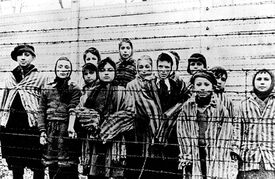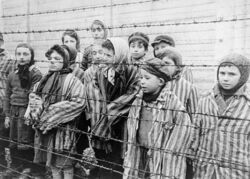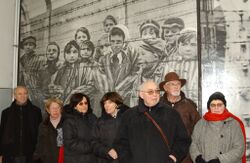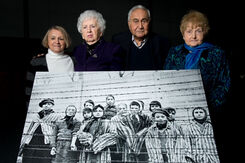Gabor Hirsch
Gabor Hirsch (M / Poland, 1929-2020), Holocaust survivor.
- <Hungary> <Auschwitz> <Mengele Twins> <Liberation of Auschwitz> -- <Switzerland>
Biography
NOTES : Gabor Hirsch was born Dec. 9, 1929, in Békéscsaba, Hungary. He was deported to Auschwitz. He survived in the camp among the Mengele Twins until January 27, 1945, when the Red Army arrived. He was reunited in Budapest with his father, also a Holocaust survivor. In 1956, during the Hungarian Revolution, he immigrated to Switzerland
He is present in an iconic Auschwitz picture, together with other Auschwitz children, including Miriam Ziegler, Pessa Balter, and Eva Kor:
Auschwitz Picture
He is present in an iconic Auschwitz picture, that depicts 13 child survivors, shortly after the liberation of the camp. All of them have been identified. From left to right they are:
- (1) Tomy Shacham / Tomy Schwarz (M / Slovakia, 1933)
- (2) Miriam Friedman / Miriam Ziegler (F / Poland, 1933)
- (3) Pessa Balter / Paula Lebovics (F / Poland, 1933)
- (4) Ruth Muschkies / Ruth Webber (F / Poland, 1935)
- (5) Bracha Katz / Berta Weinhaber (F / Slovakia, 1930)
- (6) Erika Dohan / Erika Winter (F / Czechia, 1931)
- (7) Marta Wise / Marta Slonim (F / Slovakia, 1934)
- (8) Eva Slonim / Eva Weiss (F / Slovakia, 1931)
- (9) Gabor Hirsch (M / Poland, 1929)
- (10) Gabriel Neumann / Gabriel Nejman (M / Czechia, 1937-2012)
- (11) Shmuel Schelach / Robert Schlesinger (M / Czechia, 1934-2006)
- (12 & 13) Eva & Miriam Mozes / Eva Kor (F / Romania, 1934-2019) and Miriam Zieger (F / Romania, 1934-1993).
Gabor Hirsch was not among the seven children who reunited on 27 January 2005 in the ceremony in Poland marking 60 years since the liberation of Auschwitz (photograph by Dalit Shacham). The group included (from left to right): Tomy Shacham (1); Erika Dohan (6); Marta Wise (7); Eva Slonim (8); Shmuel Schelach (11); Gabriel Neumann (10); and Bracha Katz (5).
Ten years later, he joined three other survivors who gathered in Krakow, Poland on 26 January 2015, at the invitation of the USF Shoah Foundation, on the eve of the 70th anniversary of the liberation of the death camp. The group included (from left to right): Paula Lebovics (3), Miriam Ziegler (2), Gabor Hirsch (9), and Eva Kor (12). (Photo by Ian Gavan/Getty Images).
USF Shoah Foundation
The boy standing in the very back of the photograph (usually obscured from view except his cap, but visible in images taken from different angles) has not been identified until now. He is 15 year old Gábor Hirsch, born Dec. 9, 1929, in Békéscsaba, Hungary.
Gábor was an only child and his father owned an electrical, radio and bicycle shop. He and his parents were not very religious, and Gábor went to a public gymnasium (high school) with mostly Christian students. He remembers that some of his teachers were anti-Semitic and he was harassed by other students in one incident by the school swimming pool.
The town was occupied by Germany on March 19, 1944, and by May all the Jews had been forced into small apartments and houses near the synagogue – thousands of people in just about 100 houses. By mid-June, all the Jews were sent to the Békéscsaba ghetto, located at an old tobacco factory. Though refugees from Poland and Slovakia warned them where they might be sent next, and the horrors that awaited them, Gábor’s parents didn’t believe that such a thing was possible. Yet Gábor’s father was sent with other men to a forced labor camp, and Gábor and his mother traveled to Auschwitz by cattle car with a transport of over 3,000 people, arriving on June 29, 1944.
Upon their arrival, Gábor and his mother both survived the first selection, though they each went to different camps within Auschwitz. Gábor went to the camp in Birkenau that housed Roma and Sinti people, or “gypsies,” with his older cousin Tibor. After a few months, the entire gypsy population was murdered in the gas chambers.
Gábor was able to visit his mother at her camp twice over the next three months. The second time, he brought a piece of bread for her, but instead she gave him bread of her own, with marmalade hidden in the center. It was the last time he would ever see her; she perished a few weeks later.
He passed a few more selections, but in October the Nazis sent him and 600 others to the gas chambers. They had to undress and were inside the chamber when the officers held another examination and deemed 51 boys, including Gábor, fit for work and allowed them to leave.
Gábor grew weaker and sick. By the middle of January, Nazis had started evacuating the camp on death marches to lands that were still under German control but Gábor hid under a bunk and stayed until the Soviet Army liberated the camp on Jan. 27, 1945. He recuperated in Auschwitz and other camps before reuniting with his father in Budapest.
Gábor graduated from a technical high school and continued his studies at university. In 1956, during the Hungarian Revolution, he immigrated to Switzerland, where he graduated and embarked on an electrical engineering career. He married his wife Margrit in 1968 and they had two sons, Mathias and Michael, and two grandchildren.
Jewish Telegraphic Agency (30 August 2020)
Gabor Hirsch, a Holocaust survivor who became a prominent activist for Holocaust commemoration in Switzerland, has died at 90.
Hirsch, who was born in Hungary in 1929 and died Aug. 21, survived multiple rounds of killings at Auschwitz, to which he and his mother were deported in 1944. His mother was murdered at the Stutthof concentration camp.
Hirsch returned to Hungary after the war, after spending several months recovering at a camp for displaced persons. He escaped Communist Hungary in 1956 and settled in Switzerland, where he worked as an engineer. He married his wife, Margrit in 1968, and had two sons, Mathias and Michael, and several grandchildren.
In 1994 he founded with Otto Klein, another survivor, the Kontaktstelle für Überlebende des Holocaust, a Swiss association whose name means Contact point for Holocaust survivors. He lectured before thousands of students at schools and other frameworks about the Holocaust, offered detailed accounts of his own survival.
“His testimonies were sober and for this very reason left a deep impression on his listeners,” Anita Winter wrote in an obituary published Thursday in the Neue Zürcher Zeitung, a Swiss newspaper. Winter led commemoration activities with Hirsch as founder of the Swiss Gamaraal Foundation and its project called “The Last Swiss Holocaust Survivors.”



